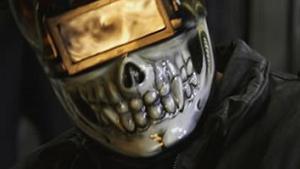
Soy sauce, TV psychics, magical Jamaicans, sentient organic computers, meat monsters, Paul Giamatti, and the constant threat of apocalypse: that’s John Dies at the End in a nutshell. Or maybe it’s Don Coscarelli in a nutshell. Of course, John Dies at the End isn’t pure Coscarelli– the cult film legend’s latest adapts the novel of the same name by one Jason Pargin, who initially had his book published back in 2007. But there’s a nagging sense of kismet that permeates the experience of watching the movie, as though Pargin wrote his story knowing that someday Coscarelli would end up translating it into cinema using his own brand of rampant comic-horror weirdness.
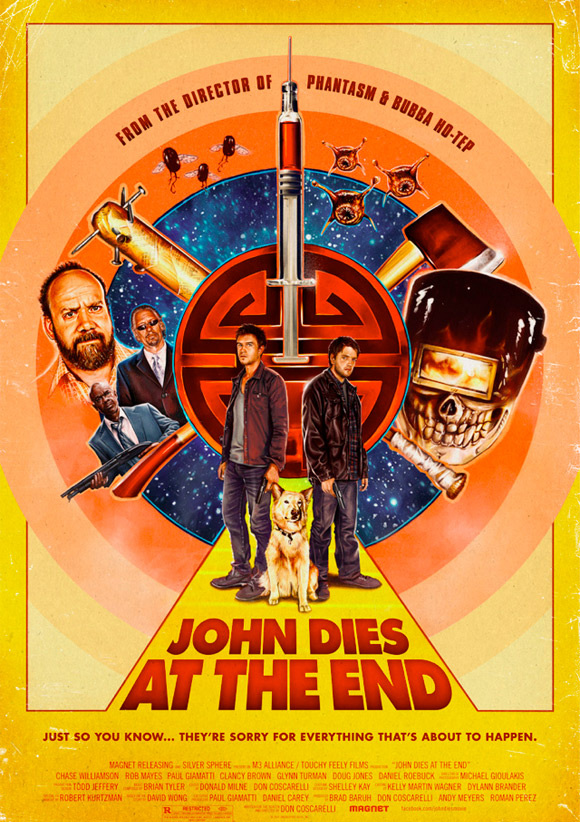 Simply put, the material and the director are a match made in heaven, assuming “heaven” is an alternate dimension where vicious man-sized spiders are employed in the wholesale slaughter of political dissenters. Structurally, John Dies at the End is built as a series of incidents and episodes, which renders its bizarreness difficult to describe in writing. Think of it as an Interview With the Vampire riff where the hero, David Wong (Pargin’s writing pseudonym), sits down to relay his dealings with the paranormal to Arnie (Giamatti, who also executive produced the film), a skeptical reporter looking for a good piece to put his name on; the particulars, mind, differ wildly, because Louis never had to face off against demonically possessed dude bros, animated severed limbs, or an undead White Power Bill.
Simply put, the material and the director are a match made in heaven, assuming “heaven” is an alternate dimension where vicious man-sized spiders are employed in the wholesale slaughter of political dissenters. Structurally, John Dies at the End is built as a series of incidents and episodes, which renders its bizarreness difficult to describe in writing. Think of it as an Interview With the Vampire riff where the hero, David Wong (Pargin’s writing pseudonym), sits down to relay his dealings with the paranormal to Arnie (Giamatti, who also executive produced the film), a skeptical reporter looking for a good piece to put his name on; the particulars, mind, differ wildly, because Louis never had to face off against demonically possessed dude bros, animated severed limbs, or an undead White Power Bill.
Substantively,John Dies at the End has much more in common with pictures like They Live, Six-String Samurai, and Buckaroo Bonzai than anything else, but a good chunk of the film revolves around back-and-forth between Arnie and Wong (Chase Williamson) as the latter tries to convince the former of the truth about soy sauce– not the popular, supremely tasty Asian condiment, though, but the unctuous black ichor that serves as the film’s hallucinogenic McGuffin. This spiky, undulating delight opens up a person’s consciousness and allows them to perceive new dimensions, remember the future, and interact with a whole host of supernatural nasties, among other things; it’s the driving force of John Dies at the End, the secret ingredient that paves the way for its relentlessly strange comings, goings, and doings.
We’re given a non-linear history lesson of how David first came into contact with the stuff: as it turns out, it’s all the fault of his slacker, druggie best friend, the eponymous John (Rob Mayes). In fact, John Dies at the End‘s primary plot line doesn’t begin in earnest until a good thirty minutes into its running time. It’s sort of a mess, one that lacks the straightforward elegance of a Bubba Ho-Tep but makes up for it with the unhinged insanity of a Phantasm. We bounce back and forth a few times before the film settles in and becomes as standard an origin story as a yarn about drugs and monsters can be, and if you’re a Coscarelli fan you probably won’t mind giving John Dies at the End time to finds its groove.
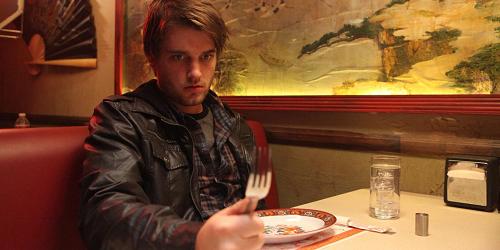
Even if you’re not, Coscarelli launches himself into Pargin’s world with gusto. Maybe that’s the ten-year gap between this and his last effort, that aforementioned Elvis/JFK/mummy film, talking (though admittedly he did direct an installment for Masters of Horror in 2005). A Coscarelli film is a rare thing these days indeed, so it’s not hard to imagine him leaping with joy at the chance to direct any horror picture put in front of him, much less one that’s so beautifully suited to his sensibilities as a filmmaker. There’s a relish to every wacky, icky, creepy, or just plain eccentric detail he squeezes into the film, from screeching alien slugs to a cloud of flies that serves as the avatar of a demon named Shi…well, you can figure that one out for yourself.
And that actually underlines one of JDATE‘s* problems: it’s packed. In under seven hundred words I’ve managed to reference over a dozen of the film’s creature components and mind-screw concepts, and I’ve neither done them justice nor managed to even scratch the surface. In theory this shouldn’t pose much of an issue to an open-minded audience willing to let Coscarelli’s endless parade of the deranged and the otherworldly march before them; take those elements as they come and run with them. You’ll do fine unless you’re resistant to what Coscarelli’s selling, in which case the deranged smorgasbord he’s assembled here might become exhausting. (Being totally honest, it’s a bit much even if you are on-board with him.)
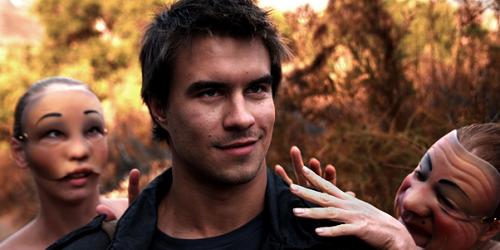
Too much of a good thing, though, isn’t the same as any amount of a bad thing, so it’s hard to hold John Dies at the End‘s indulgences against it. If the film is packed to the gills with a gruesome, spooky oddities, at least they’re constructed and utilized really, really well and in the service of something original. It helps, too, that Coscarelli anchors John Dies at the End with a likeable pair of protagonists played by a solid duo of actors. Williamson and Mayes have an easy, real chemistry bolstered by odd couple tension; Mayes doesn’t bat an eye at the unceasing kookiness they confront together, but Williamson reacts to all of it with dumbfounded stares and furrowed brows. They’re a fun team, though the narrative splits them up and leaves us alone with Williamson more often than not.
G-S-T Ruling:
They’re joined by a fantastic supporting cast; Giamatti smirks skeptically and huffs in curmudgeonly disbelief, while Clancy Brown makes a meal out of his limited screen time as a mystical television guru who happens to be a legit demon hunter. (And Doug Jones shows up as…Doug Jones. Basically.) Frankly, the secondaries alone might be enough to get any B-horror or all-around genre diehards into theaters, but Coscarelli’s such an institution in that arena that his name is all anybody needs for John Dies at the End to hook them. His films, few and far between, always feel like events, and though John Dies at the End is a bit slight as a follow-up to Bubba Ho-Tep, it’s still Coscarelli in his element. And that’s always worth watching.
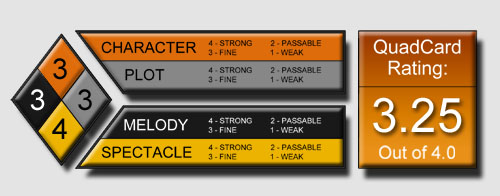
*A clever and misleading acronym, though I’m not sure if Pargin did it on purpose or not.

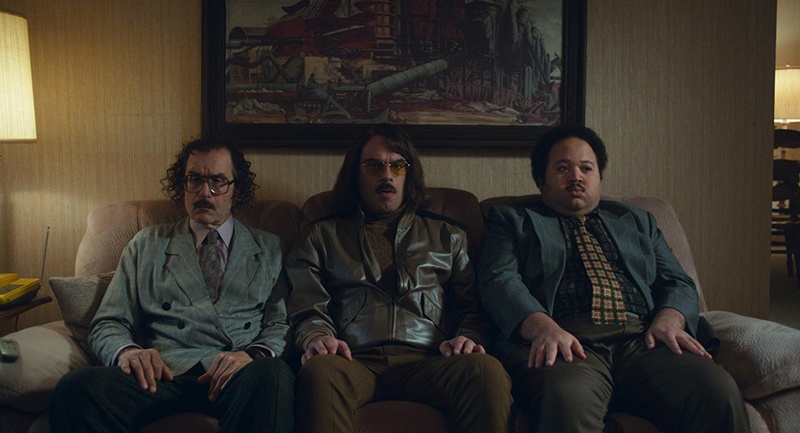

4 Comments
Colin "Fitz" Biggs
Sounds thoroughly devious. Makes me want to watch Bubba Ho-Tep again.
Andrew Crump
I’ll be honest, I had the same reaction– though I also wanted to just start John Dies at the End over again once it finished. It’s good stuff.
Colin "Fitz" Biggs
Good to hear.
RidgeRacer4
If David Cronenberg and John Carpenter’s movies had a key party, 9 months later the result would be John Dies At the End. Nice review Andrew…now I’m going to spend the whole weekend trying to figure out what I just saw; )